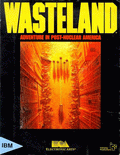
































Wasteland

Wasteland is a science fiction role-playing video game developed by Interplay Productions and first published by Electronic Arts for the Commodore 64, Apple II, and PC DOS in 1988. The game is set in a futuristic, post-apocalyptic America that was destroyed by nuclear holocaust generations before. It was re-released for Microsoft Windows, OS X, and Linux in 2013 by inXile Entertainment.
Critically acclaimed and commercially successful, Wasteland was intended to be followed by two separate sequels, but Electronic Arts' Fountain of Dreams was turned into an unrelated game and Interplay's own Meantime was cancelled. The game's general setting and concept, however, became the basis for Interplay's 1997 role-playing video game Fallout, which itself would extend into a successful series. A sequel, Wasteland 2, was developed by inXile Entertainment and published on September 19, 2014.
In the year 2087, following the devastation of a global nuclear war in 1998, a remnant force of the United States Army calling themselves the Desert Rangers is based in the Southwestern United States. A team of Desert Rangers is assigned to investigate a series of disturbances in the nearby areas and, throughout the game, explores the remaining enclaves of human civilization, including a post-apocalyptic Las Vegas.
Over the course of the game, the player's party discovers evidence of a larger menace that threatens to exterminate what is left of the human kind in the game's region and eventually the world. It is a pre-war AI computer that is operating from a surviving military facility Base Cochise, where it is constructing armies of killer machines and cybernetically modified humans with which it is attacking settlements; its goal is to replace the current 'flawed' population with genetically pure specimens. With the help from a pre-war android named Max, the player recovers the necessary technology and weapons in order to confront the computer at its base and stop it by making the base's nuclear reactor melt down.
The game mechanics were based directly on those used in the tabletop role-playing games Tunnels and Trolls and Mercenaries, Spies and Private Eyes created by Wasteland designers Ken St. Andre and Michael Stackpole. Characters in Wasteland consequently have various statistics (strength, intelligence, and luck among others) that allow them to use different skills and weapons. Experience is gained through battle and through use of skills. The game would generally let players advance with a variety of tactics: to get through a locked gate, the characters could use their picklock skill, their climb skill, or their strength attribute; or they could force the gate with a crowbar – or a LAW rocket.
The player's party begins with four characters, and through the course of the game can hold as many as seven characters by recruiting certain citizens and creatures of the wasteland to the player's cause. The initial band encounter a number of NPCs as the game progressed who could be recruited into the party. Unlike those of other computer RPGs of the time, these NPCs might temporarily refuse to give up an item or perform an action if ordered to do so. The game was also noted for its high and unforgiving difficulty level and for such combat prose as 'reduced to a thin red paste' and 'explodes like a blood sausage', which prompted an unofficial PG-13 sticker on the game packaging in the United States.
Wasteland was one of the first games featuring a persistent world, where changes to the game world were stored and kept. Returning to areas later in the game, one would find them in the state one left them in, instead of being reset to their original state, as was common for games of the time. Since hard drives were still rare in home computers in 1988, this meant the original game disk had to be copied first, as the manual instructed one to do.
One of the other features of this game was the inclusion of a printed collection of paragraphs which the game would instruct the player to read at the appropriate times. These paragraphs described encounters and conversations, contained clues, and added to the overall texture of the game. Because programming space was at a premium, it saved on resources to have most of the game's story printed out in a separate manual rather than store it within the game's code itself. The paragraph books also served as a rudimentary form of copy protection, as someone playing a copied version of the game would miss out on much of the story as well as clues necessary to progress. Additionally, the paragraphs included a completely unrelated story line about a mission to Mars intended to mislead those who read the paragraphs when not instructed to, and a false set of passwords that would trip up cheaters with results that ranged from character sex changes to unintentionally detonating a bomb.
How to play:
Click on the joystick icon in the Wasteland online emulator to see how to control the Wasteland game









































Comments